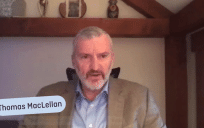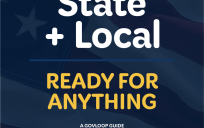Recently the trickle-down effect of federal cuts started impacting states directly. Twenty-thousand job cuts in Health and Human Services (HHS) at the federal level is the tip of the iceberg in $12 billion in cuts to the infrastructure that tracks little things like measles, bird flu, and COVID-19.

Extrapolated from cuts in Connecticut, this affected about 2,000 to 2,500 contracting positions nationwide. (We won’t know exact numbers until the dust settles.) Over the next month or so, based on state budget juggling and union issues, this is likely to impact an additional 10,000 or more full-time public health workers at the state level. This doesn’t even include jobs lost from contracts being canceled with different company partners.
Whether you know or see the impact of public health workers in your state, you will see the trickledown effect of the $150M (average) removed from your local economy. The HHS cuts will likely significantly impact public health at the state and local levels. Here are some key areas of concern.
Reduced Disease Surveillance and Outbreak Response
The Centers for Disease Control (CDC) job losses will slow responses to disease outbreaks like flu, COVID-19, and emerging threats like measles. An outbreak in West Texas has already spread to Ohio. Unlike flu or COVID, measles is so contagious, you can get it from being in the same space where an infected person was two hours before. Be prepared to watch it spread even more rapidly with fewer people trying to contain it.
State and local health departments rely on CDC funding and expertise — less support could mean slower tracking and containment of infectious diseases. Outbreaks of all kinds are likely to spread faster and be contained less quickly due to funding cuts.
Fewer Resources for Public Health Programs
Many HHS grants support immunization programs, maternal health, and chronic disease prevention at the local level. With fewer resources, programs like free vaccinations and diabetes prevention could shrink or disappear. Community health worker programs that address social determinants of health will be cut back in many communities.
Programs addressing opioid addiction, mental health, and homelessness will face cutbacks, impacting vulnerable populations. This will leave state and local governments with a new set of problems to deal with, and no funding to go along with it.
Challenges in Healthcare Access and Insurance Support
The Centers for Medicare & Medicaid Services (CMS) will lose at least 300 employees, potentially delaying Medicaid and Medicare enrollment processing. Additionally, a 2.8% reduction in Medicare physician fees is likely to further impact health care for our most vulnerable populations.
The Trump administration is committed to reducing fraud in government programs. The HHS cuts could actually create a ripe environment for fraud to flourish. Reduced oversight could lead to fraud and inefficiencies in healthcare funding, affecting hospitals and low-income individuals relying on government programs.
Impact on Drug Safety and Medical Research
The Food and Drug Administration’s loss of 3,500 employees could slow drug approvals and food safety inspections, leading to delays in getting new medications and treatments to the public. Clinical trials for new drugs are going to be significantly affected. I recently lost a family member to amyotrophic lateral sclerosis, aka ALS. With 15 new cases per day, this is just one example of where we need faster drug approval.
The NIH losing 1,200 workers means fewer medical research grants, possibly slowing advancements in cancer treatments, Alzheimer’s research, and other critical health studies. Most of the work on these grants is conducted at local colleges and not some government facility. We are all likely to see the impact of these cuts in our communities.
Reduced Emergency Preparedness
While the recent attention from flooding and fires tends to focus on the Federal Emergency Management Agency, they are just one piece of the emergency preparedness equation. HHS plays a key role in coordinating responses to natural disasters, bioterrorism threats, and pandemics. Cuts may lead to slower responses and less federal coordination in emergencies. In areas already suffering from disasters, the situation is likely to get worse.
The closure of regional offices could weaken the connection between federal and state health departments, reducing efficiency in crisis management. Regional offices help ensure access and local knowledge about potential disaster scenarios. Centralizing any government function makes it less resilient.
Conclusion
These changes will likely place a greater burden on state and local governments to fill gaps left by federal cuts. Doing more with less is not a long-term strategy. Eventually, things just break. Many public health experts and local officials fear these reductions could make communities more vulnerable to health crises, while also increasing healthcare disparities.
State and local governments need to start looking for creative solutions to some of these challenges. It’s too soon to tell what might be possible, but the cavalry isn’t coming. Do what you can and share what is working and what isn’t. There are plenty of ways to make our government more efficient and save money. This is not one of them.
Robert Longley is a coach, consultant, writer and avid traveler who lives in the small town of Williamsburg, Massachusetts. When he isn’t writing, painting, kayaking or renovating his kids’ houses, he primarily works with state and local government agencies and entrepreneurs. He writes about the future of work, sustainability and our personal connections. He has also written several poetry books including three for Gold Star Military Families and families of fallen police and firefighters. His poems have been featured on television shows and on various monuments on both sides of the Atlantic. He and his wife have two grown daughters, and an assortment of four legged creatures still living at home.





Leave a Reply
You must be logged in to post a comment.